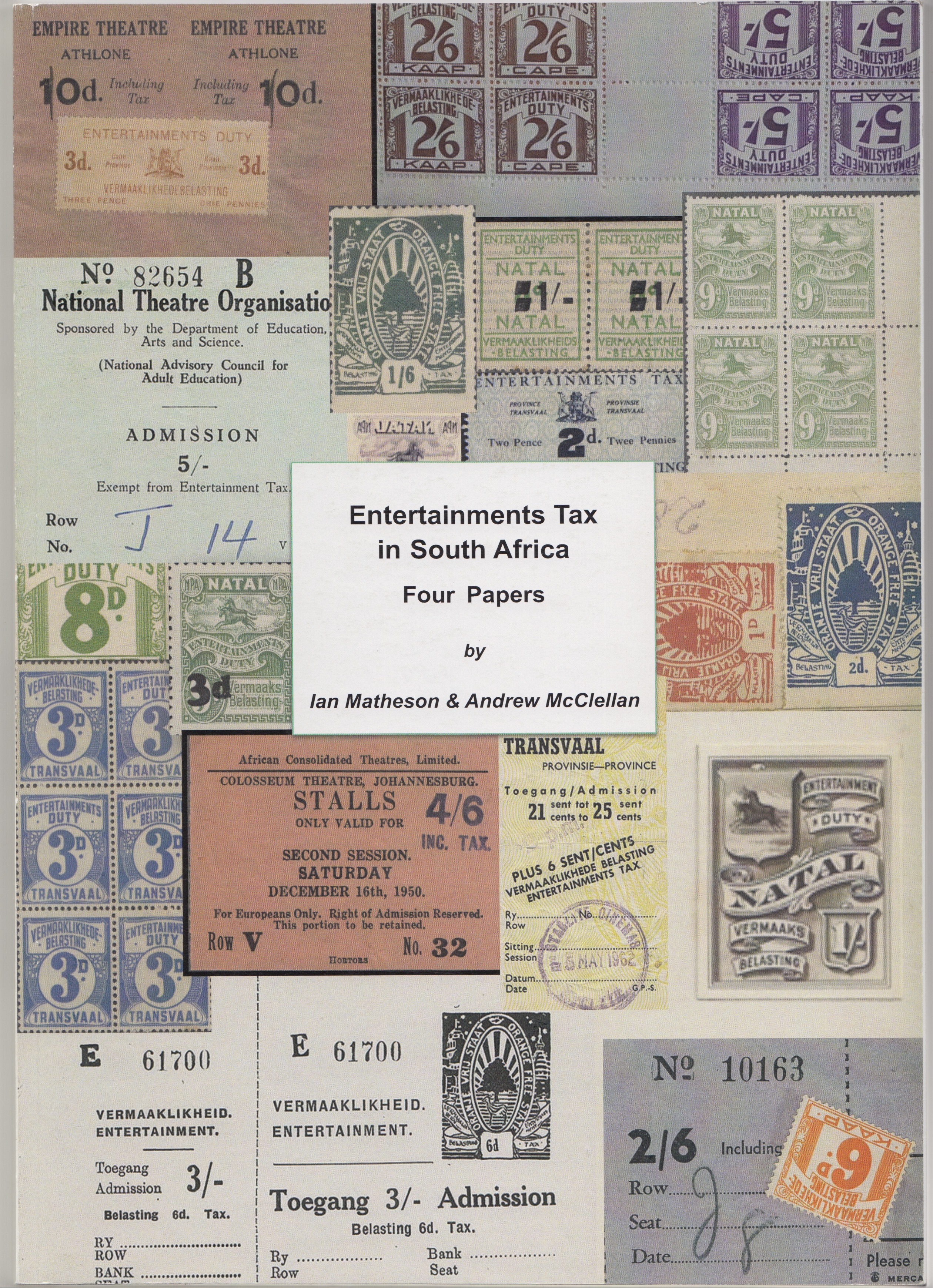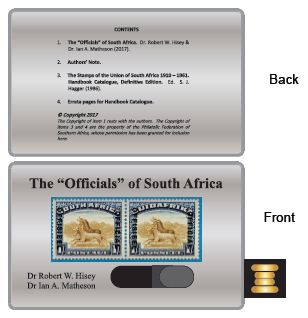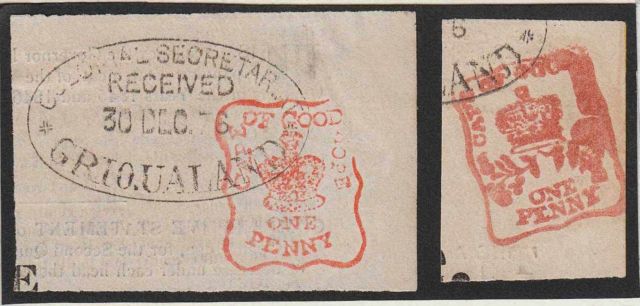Cape of Good Hope: Newspaper mail
Quote from Steve on October 16, 2020, 9:53 amI have to laugh here. Britishhonduras will get it. I shall leave it to him to explain. Just let me say that if we ever receive a better introductory post than this on the South African Philately Club website, it will have to be spectacularly stellar. This is an awesome and wonderful contribution by britishhonduras on a subject that gets little coverage. We are truly fortunate to see it here in such detail. My thanks to founding member Yannis for making the original Newspaper Mail post, to co-founder Jamie Smith for keeping me going when I began to doubt if anyone was following us and most especially now to britishhonduras for joining in without solicitation to generously share this superb display with us despite the frustrations of some awkward technical issues. Well done, guys!
I have to laugh here. Britishhonduras will get it. I shall leave it to him to explain. Just let me say that if we ever receive a better introductory post than this on the South African Philately Club website, it will have to be spectacularly stellar. This is an awesome and wonderful contribution by britishhonduras on a subject that gets little coverage. We are truly fortunate to see it here in such detail. My thanks to founding member Yannis for making the original Newspaper Mail post, to co-founder Jamie Smith for keeping me going when I began to doubt if anyone was following us and most especially now to britishhonduras for joining in without solicitation to generously share this superb display with us despite the frustrations of some awkward technical issues. Well done, guys!
Quote from britishhonduras on October 16, 2020, 11:15 amIn response to post 19 (Yannis) I think the stop is identical to yours on the stamp of doubt. There would be no requirement for a cancellation on the revenue stamp unless (i) the newspaper had been posted and the cancellation was applied unnecessarily over the revenue stamp, or (ii) the revenue stamp was being fraudulently used for postage. The latter is unlikely, but we know of numerous revenue stamps being used for postage elsewhere. I have no reason whatsoever to doubt the authenticity of the piece.
Oscar van der Vliet posted on another Facebook Group a scan of newspaper stamps cancelled in Griqualand West long after the end of newspaper tax. Maybe they were being entered into an archive and this was like a library receipt mark? Otherwise I cannot explain them.
In response to post 19 (Yannis) I think the stop is identical to yours on the stamp of doubt. There would be no requirement for a cancellation on the revenue stamp unless (i) the newspaper had been posted and the cancellation was applied unnecessarily over the revenue stamp, or (ii) the revenue stamp was being fraudulently used for postage. The latter is unlikely, but we know of numerous revenue stamps being used for postage elsewhere. I have no reason whatsoever to doubt the authenticity of the piece.
Oscar van der Vliet posted on another Facebook Group a scan of newspaper stamps cancelled in Griqualand West long after the end of newspaper tax. Maybe they were being entered into an archive and this was like a library receipt mark? Otherwise I cannot explain them.
Quote from britishhonduras on October 16, 2020, 11:29 amI have not seen that book for many years, Jamie. I parted with some of the stamps and covers described there in Spink's January sale, but it is still my number one interest, closely followed by revenues of the world (especially entertainment tax). May I take the opportunity to recommend another couple of publications by the same author, one published only in soft copy and the other in both soft and hard.
I have not seen that book for many years, Jamie. I parted with some of the stamps and covers described there in Spink's January sale, but it is still my number one interest, closely followed by revenues of the world (especially entertainment tax). May I take the opportunity to recommend another couple of publications by the same author, one published only in soft copy and the other in both soft and hard.
Uploaded files:Quote from Jamie Smith on October 16, 2020, 12:09 pmThe club is a wonderful arena for bringing 'old time' philatelists out of the wood work. I have met so many over the last few months and being an emotional person.... You can only guess. Mind you I am still trying to decide whether to forgive you for your comments thirty years ago when you were asked at the Johannesburg P/S to comment on my 'G.B. Queen Elizabeth II' display, your opening words were "This attempt at 'modern' postal history..........". Now I realise that you were right so.... You are forgiven!
Jamie.
The club is a wonderful arena for bringing 'old time' philatelists out of the wood work. I have met so many over the last few months and being an emotional person.... You can only guess. Mind you I am still trying to decide whether to forgive you for your comments thirty years ago when you were asked at the Johannesburg P/S to comment on my 'G.B. Queen Elizabeth II' display, your opening words were "This attempt at 'modern' postal history..........". Now I realise that you were right so.... You are forgiven!
Jamie.
Quote from yannisl on October 16, 2020, 12:11 pm@britishhonduras
Thanks for your suggestions. I think (i) being the most likely. As postage stamps were only introduced in 1853 one can exclude (ii) and (iii). I have another one from Grahamstown (in very bad condition) with remnants of what I think is a crown-in-circle at one corner. The custom at the time for letters was that they would have a "POST PAID" or "TO PAY" handstamp as well as one of the DLS handstamps. My thoughts are that the postmaster could have stamped these on the top of the newspaper bundle that he was handling, if it was in a bundle and hence the fact that we haven't seen other surviving pieces. On the headpiece of the Grahamstown Journal one can see that subscriptions included postage; The postage paid to the Post Master must have been in cash (like the letters) but in the absence of further evidence, we can only speculate if there was a need to mark the payment on the newspaper. There is also the possibility that even in this early days wrappers were also used and these have not survived the passage of time.
One comment on your absolutely magnificent display, is that you say the stamps were sometimes printed in sheets (before being cut). I personally think they were handstamped on the sheets and hence the volatility of the ink.
As to the postally used revenue stamps I personally think is that most of them are Jurgen's fakes and genuine ones are very few.
I am intrigued about the Griqualand West post by Oscar van der Vliet. I searched but cannot find a link through Google, would you be kind enough to post it here?
@britishhonduras
Thanks for your suggestions. I think (i) being the most likely. As postage stamps were only introduced in 1853 one can exclude (ii) and (iii). I have another one from Grahamstown (in very bad condition) with remnants of what I think is a crown-in-circle at one corner. The custom at the time for letters was that they would have a "POST PAID" or "TO PAY" handstamp as well as one of the DLS handstamps. My thoughts are that the postmaster could have stamped these on the top of the newspaper bundle that he was handling, if it was in a bundle and hence the fact that we haven't seen other surviving pieces. On the headpiece of the Grahamstown Journal one can see that subscriptions included postage; The postage paid to the Post Master must have been in cash (like the letters) but in the absence of further evidence, we can only speculate if there was a need to mark the payment on the newspaper. There is also the possibility that even in this early days wrappers were also used and these have not survived the passage of time.
One comment on your absolutely magnificent display, is that you say the stamps were sometimes printed in sheets (before being cut). I personally think they were handstamped on the sheets and hence the volatility of the ink.
As to the postally used revenue stamps I personally think is that most of them are Jurgen's fakes and genuine ones are very few.
I am intrigued about the Griqualand West post by Oscar van der Vliet. I searched but cannot find a link through Google, would you be kind enough to post it here?
Quote from britishhonduras on October 16, 2020, 1:23 pmI have asked Oscar for a scan and will upload it if I get it.
Yes, the sheets were certainly "printed" one stamp at a time. I was delighted to receive the newspapers showing the stamps with portions of adjacent stamps. It was the first time I had seen this.
I have asked Oscar for a scan and will upload it if I get it.
Yes, the sheets were certainly "printed" one stamp at a time. I was delighted to receive the newspapers showing the stamps with portions of adjacent stamps. It was the first time I had seen this.
Quote from britishhonduras on October 16, 2020, 8:45 pmI received the images from Oscar.
I received the images from Oscar.
Uploaded files:Quote from yannisl on October 17, 2020, 8:12 amThanks, definitely "office receipt stamp". There are similar markings on newspapers with "COLONIAL OFFICE/CAPETOWN" in the University of California collection.
Thanks, definitely "office receipt stamp". There are similar markings on newspapers with "COLONIAL OFFICE/CAPETOWN" in the University of California collection.
Quote from Steve on October 18, 2020, 9:25 amSo.... Back to the original question posed on the Home Page, "IS THIS SOUTH AFRICA’S FIRST ADHESIVE STAMP?"
We agree with britishhondurad that "The stamps are pure revenue stamps as outlined in the Ordinance of 1826." The question is "were there other adhesive stamps used in South Africa, then just the Cape, before these Newspaper revenue stamps? What of the VOC revenues?"
So.... Back to the original question posed on the Home Page, "IS THIS SOUTH AFRICA’S FIRST ADHESIVE STAMP?"
We agree with britishhondurad that "The stamps are pure revenue stamps as outlined in the Ordinance of 1826." The question is "were there other adhesive stamps used in South Africa, then just the Cape, before these Newspaper revenue stamps? What of the VOC revenues?"
Quote from Johan64 on October 18, 2020, 12:56 pmThis is an amazing thread with some information I have never seen before - thank you. Do you have similar information on Transvaal Newspaper Mail at all?
This is an amazing thread with some information I have never seen before - thank you. Do you have similar information on Transvaal Newspaper Mail at all?



